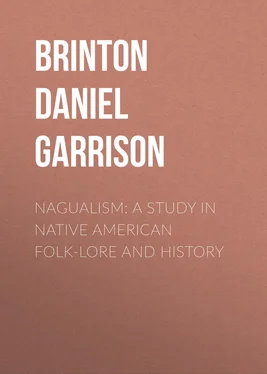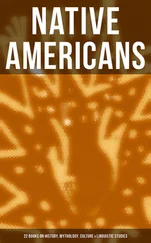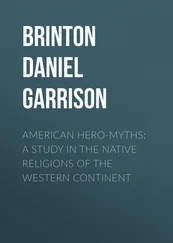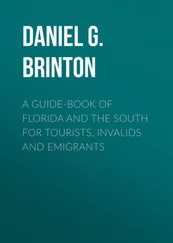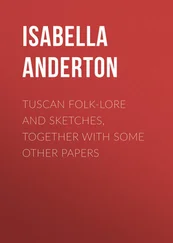Daniel Brinton - Nagualism - A Study in Native American Folk-lore and History
Здесь есть возможность читать онлайн «Daniel Brinton - Nagualism - A Study in Native American Folk-lore and History» — ознакомительный отрывок электронной книги совершенно бесплатно, а после прочтения отрывка купить полную версию. В некоторых случаях можно слушать аудио, скачать через торрент в формате fb2 и присутствует краткое содержание. ISBN: , Жанр: foreign_antique, foreign_prose, на английском языке. Описание произведения, (предисловие) а так же отзывы посетителей доступны на портале библиотеки ЛибКат.
- Название:Nagualism: A Study in Native American Folk-lore and History
- Автор:
- Жанр:
- Год:неизвестен
- ISBN:http://www.gutenberg.org/ebooks/26426
- Рейтинг книги:4 / 5. Голосов: 1
-
Избранное:Добавить в избранное
- Отзывы:
-
Ваша оценка:
- 80
- 1
- 2
- 3
- 4
- 5
Nagualism: A Study in Native American Folk-lore and History: краткое содержание, описание и аннотация
Предлагаем к чтению аннотацию, описание, краткое содержание или предисловие (зависит от того, что написал сам автор книги «Nagualism: A Study in Native American Folk-lore and History»). Если вы не нашли необходимую информацию о книге — напишите в комментариях, мы постараемся отыскать её.
Nagualism: A Study in Native American Folk-lore and History — читать онлайн ознакомительный отрывок
Ниже представлен текст книги, разбитый по страницам. Система сохранения места последней прочитанной страницы, позволяет с удобством читать онлайн бесплатно книгу «Nagualism: A Study in Native American Folk-lore and History», без необходимости каждый раз заново искать на чём Вы остановились. Поставьте закладку, и сможете в любой момент перейти на страницу, на которой закончили чтение.
Интервал:
Закладка:
“These are those who in all the provinces of New Spain are known by the name of Nagualists . They pretend that the birth of men is regulated by the course and movements of stars and planets, and by observing the time of day and the months in which a child is born, they prognosticate its condition and the events, prosperous or otherwise, of its life; and the worst is that these perverse men have written down their signs and rules, and thus deceive the erring and ignorant.
“These Nagualists practice their arts by means of Repertories and superstitious Calendars, where are represented under their proper names all the Naguals of stars, elements, birds, fishes, brute beasts and dumb animals; with a vain note of days and months, so that they can announce which corresponds to the day of birth of the infant. This is preceded by some diabolical ceremonies, after which they designate the field or other spot, where, after seven years shall have elapsed, the Nagual will appear to ratify the bargain. As the time approaches, they instruct the child to deny God and His Blessed Mother, and warn him to have no fear, and not to make the sign of the cross. He is told to embrace his Nagual tenderly, which, by some diabolical art, presents itself in an affectionate manner even though it be a ferocious beast, like a lion or a tiger. Thus, with infernal cunning they persuade him that this Nagual is an angel of God, who will look after him and protect him in his after life.
“To such diabolical masters the intelligent Indians apply, to learn from these superstitious Calendars, dictated by the Devil, their own fortunes, and the Naguals which will be assigned to their children, even before they are baptized. In most of the Calendars, the seventh sign is the figure of a man and a snake, which they call Cuchulchan. The masters have explained it as a snake with feathers which moves in the water. This sign corresponds with Mexzichuaut, which means Cloudy Serpent, or, of the clouds. 39 39 Rather with the Quetzalcoatl of the Nahuas, and the Gucumatz of the Quiches, both of which names mean “Feathered Serpent.” Mixcohuatl, the Cloud Serpent, in Mexican mythology, referred to the Thunder-storm.
The people also consult them in order to work injury on their enemies, taking the lives of many through such devilish artifices, and committing unspeakable atrocities.
“Worse even than these are those who wander about as physicians or healers; who are none such, but magicians, enchanters, and sorcerers, who, while pretending to cure, kill whom they will. They apply their medicines by blowing on the patient, and by the use of infernal words; learned by heart by those who cannot read or write; and received in writing from their masters by those acquainted with letters. The Master never imparts this instruction to a single disciple, but always to three at a time, so that in the practice of the art it may be difficult to decide which one exerts the magical power. They blow on feathers, or sticks, or plants, and place them in the paths where they may be stepped on by those they wish to injure, thus causing chills, fevers, ugly pustules and other diseases; or they introduce into the body by such arts toads, frogs, snakes, centipedes, etc, causing great torments. And by these same breathings and magic words they can burn down houses, destroy the growing crops and induce sickness. No one of the three disciples is permitted to practice any of these arts without previously informing the other two, and also the Master, by whom the three have been taught.
“We have learned by the confession of certain guilty parties how the Master begins to instruct his disciple. First he tells him to abjure God, the saints and the Virgin, not to invoke their names, and to have no fear of them. He then conducts him to the wood, glen, cave or field where the pact with the Devil is concluded, which they call ‘the agreement’ or ‘the word given’ (in Tzental quiz ). In some provinces the disciple is laid on an ant-hill, and the Master standing above him calls forth a snake, colored with black, white and red, which is known as ‘the ant-mother’ (in Tzental zmezquiz ). 40 40 In his Tzental Vocabulary, Father Lara does not give this exact form; but in the neighboring dialect of the Cakchiquel Father Ximenes has quikeho , to agree together, to enter into an arrangement; the prefix zme is the Tzental word for “mother.”
This comes accompanied by the ants and other small snakes of the same kind, which enter at the joints of the fingers, beginning with the left hand, and coming out at the joints of the right hand, and also by the ears and the nose; while the great snake enters the body with a leap and emerges at its posterior vent. Afterwards the disciple meets a dragon vomiting fire, which swallows him entire and ejects him posteriorly. Then the Master declares he may be admitted, and asks him to select the herbs with which he will conjure, the disciple names them, the Master gathers them and delivers them to him, and then teaches him the sacred words.
“These words and ceremonies are substantially the same in all the provinces. The healer enters the house of the invalid, asks about the sickness, lays his hand on the suffering part, and then leaves, promising to return on the day following. At the next visit he brings with him some herbs which he chews or mashes with a little water and applies to the part. Then he repeats the Pater Noster
Конец ознакомительного фрагмента.
Текст предоставлен ООО «ЛитРес».
Прочитайте эту книгу целиком, купив полную легальную версию на ЛитРес.
Безопасно оплатить книгу можно банковской картой Visa, MasterCard, Maestro, со счета мобильного телефона, с платежного терминала, в салоне МТС или Связной, через PayPal, WebMoney, Яндекс.Деньги, QIWI Кошелек, бонусными картами или другим удобным Вам способом.
1
These words occur a number of times in the English translation, published at London in 1822, of Dr. Paul Felix Cabrera’s Teatro Critico Americano . The form nagual instead of nahual , or naual , or nawal has been generally adopted and should be preferred.
2
For instance, in “The Names of the Gods in the Kiche Myths,” pp. 21, 22, in Proceedings of the American Philosophical Society , 1881; Annals of the Cakchiquels , Introduction, p. 46; Essays of an Americanist , p. 170, etc.
3
Historia de las Indias Occidentales , Dec. iv, Lib. viii, cap. 4.
4
More especially it is the territory of the Chorti dialect, spoken to this day in the vicinity of the famous ancient city of Copan, Honduras. Cerquin lies in the mountains nearly due east of this celebrated site. On the Chorti, see Stoll, Zur Ethnographie der Republik Guatemala , pp. 106-9.
5
Bernardino de Sahagun, Historia de la Nueva España , Lib. x, cap. 9.
6
Derived from teciuhtlaza , to conjure against hail, itself from teciuh , hail. Alonso de Molina, Vocabulario Mexicano , sub voce.
7
Bautista, Advertencias para los Confesores , fol. 112 (Mexico, 1600).
Читать дальшеИнтервал:
Закладка:
Похожие книги на «Nagualism: A Study in Native American Folk-lore and History»
Представляем Вашему вниманию похожие книги на «Nagualism: A Study in Native American Folk-lore and History» списком для выбора. Мы отобрали схожую по названию и смыслу литературу в надежде предоставить читателям больше вариантов отыскать новые, интересные, ещё непрочитанные произведения.
Обсуждение, отзывы о книге «Nagualism: A Study in Native American Folk-lore and History» и просто собственные мнения читателей. Оставьте ваши комментарии, напишите, что Вы думаете о произведении, его смысле или главных героях. Укажите что конкретно понравилось, а что нет, и почему Вы так считаете.
